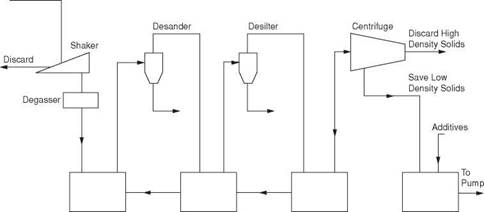 Solids Control Systems
Solids Control Systems
The components discussed above are configured in such a way as to remove the unwanted solids as efficiently as possible whilst ensuring that the solids which are mixed into the mud to maintain viscosity (Bentonite) and density (Barite are not removed from the system.
a. Unweighted Muds (Figure 22)
When configuring a system for an unweighted mud, the various solids control components are arranged in decreasing order of particle size removed to prevent clogging. Dilution is used upstream of the hydrocyclones to increase their separation efficiency. Having passed through the solids control equipment the mud should consist of water, well-dispersed bentonite and very fine drill solids. It can then be diluted, treated with chemicals, and conditioned, prior to being re-circulated.
|
Mud
Dilution Dilution Dilution Suction Pit Figure 22 Solids Control System for an Un-weighted Mud |
b. Weighted Muds (Figure 23)
Hydrocyclones cannot, be used alone for weighted muds since they will discard barite. A mud cleaner may however be used to overcome this problem. As with unweighted muds water is used for diluting upstream of the mud cleaner and the centrifuge. Notice that the low density solids in the liquid phase are discarded from the centrifuge, while the solids (barite) are retained. The chemicals and bentonite discarded with the liquid phase must be replaced. The optimum solids content in a weighted mud is difficult to determine.
|
|
|
Mud Cleaner |
|
Dilution |
|
Dilution |
|
Suction Pit |
|
Figure 23 Solids Control System for a Weighted Mud |
The group of minerals classified as clays play a central role in many areas of drilling fluid technology. The clay group can be described chemically as aluminium silicates. Since the elements that constitute the clays account for over 80 % of the mass of the earth (aluminium 8.1%, silicon 27.7% and oxygen 46.6%) it can readily be appreciated that virtually every stage in the drilling of a hole will bring contact with clay. Clays are often used to derive the viscous properties of the drilling fluid and since clays will also be encountered during the drilling of the hole many of the chemicals used to ‘condition’ the mud are used to control these properties.

